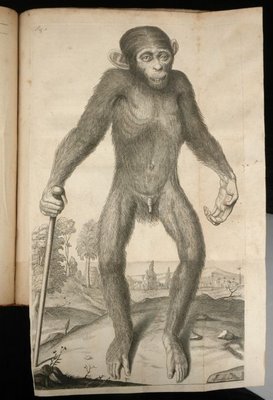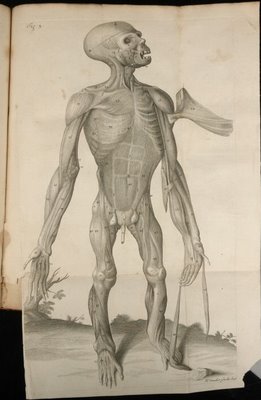"I take him to be wholly a Brute, tho' in the formation of the Body, and in the Sensitive or Brutal Soul, it may be, more resembling a Man, than any other Animal; so that in this Chain of the Creation, as an intermediate Link between an Ape and a Man, I would place our Pygmie."

 “one would be apt to think, that since there is so great a disparity
“one would be apt to think, that since there is so great a disparitybetween the Soul of a Man, and a Brute, the Organ likewise in
which ’tis placed should be very different too.”





[click for full size versions]
Edward Tyson (1650–1708) was an English physician and member of the Royal Society. Beyond his medical duties and publications (both of which were significant and extensive) he had a deep interest in comparative anatomy, an area of scientific investigation in which he is one of the leading early protagonists.
In 1680 he had already outlined this interest in 'Phocaena or the Anatomy of the Porpess' in which he not only systematically described cetacean structures but also wrote of "the importance of a comparative approach to anatomy and attempts to develop a plan for a natural history of animals." He performed dissections on many different species and published his findings in the 'Philosophical Transactions of the Royal Society'.
In the late 1690s a chimpanzee had only been seen illustrated in Europe once previously and the larger apes such as the orangutan and gorilla were not discovered or described until the 18th and 19th centuries respectively. It was not surprising therefore that Tyson was given the opportunity to dissect a chimpanzee that had been brought over from Africa in 1698.
The chimpanzee was a juvenile (which led to some erroneous anatomical statements) and was injured on board its transport ship. The injury later became infected and caused the chimp's death. This injury is either directly or inadvertently represented in the engraving above (all the drawings were done by the anatomist William Cowper) in which the bipedal chimp is seen using a walking stick. Tyson described the animal as quadru-manous to distinguish it from the quadrupeds.
The reference to 'Orang-Outang' in the title is only in terms of it meaning "man of the woods" [homo silvestris]. So it was that 'The Anatomy of a Pygmie' marked the beginning of primatology, and there is some irony in Tyson having been a distant cousin of Charles Darwin. I haven't searched around but I would not be surprised to learn that the expression 'the missing link' derives from Tyson's meticulous documentation of the anatomical comparison between chimpanzees and man.
- The above images have been snagged from a first edition (1699) copy of 'Orang-Outang, sive Homo Sylvestris: or, the Anatomy of a Pygmie compared with that of a Monkey, an Ape, and a Man' on ebay. To the best of my searching capabilities there are no copies online and only a couple of the above fold-out engravings have been previously digitized (and these images above are better quality in my opinion than any others I encountered, including one image at the British Library). I think there were only 8 large illustrations in the first edition so this is nearly complete.
- In addition to the main text, Tyson also contributed 4 essays that were included as an appendix to the book. As the title page intimates, a large part of Tyson's intention when undertaking the project was to prove that mythical dwarf creatures which had been previously described as human were plausible animals, but were in fact apes. The first essay -- 'A Philological Essay Concerning the Pygmies of the Ancients' -- is really a kind of review of 'dwarfian' mythology or historical literature review and is available from Project Gutenburg, with a substantial 1894 introduction by Bertram Windle. It is rather fascinating to skim through.
- Kings College London: 'Anatomy of a Pygmy' exhibition page.
- 'Anatomy of a Pygmie' was re-released in 1966 and a 1967 review by KF Russell is available from pubmedcentral.
- 'Searching for Your Inner Chimp' by Carl Zimmer 2002.
- 'Selected Minor Works: Historical Reflections on Language and Bipedalism' by Justin Smith 2006.
- 'Evidence as to Man's Place in Nature' by Thomas Henry Huxley 1863 at Project Gutenburg.
- 'Four Hands Good, Two Hands Bad' 2006 by Tom Tyler (Senior Lecturer in Communication, Media and Culture at Oxford Brookes University UK).
- This page from Jonathan Marks at UNC Charlotte has a couple of images inspired by those from Tyson/Cowper.
- Previously: comparative mammalian anatomy and historical anatomies.
No comments:
Post a Comment